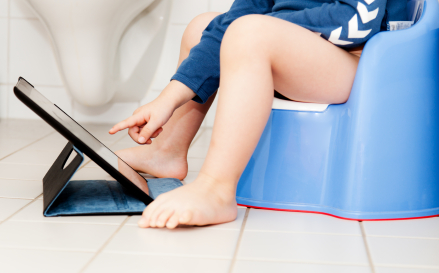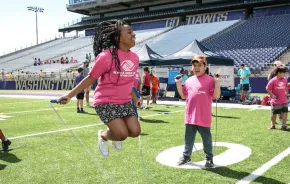 Sarah Stetner of Marysville is proudly raising two young techies. Her sons, Gabriel, 3, and Isaiah, 6, are media mavens who know their way around an iPad — and almost every other device on the market. “Leapster, iPad, Wii, Xbox, computer, they do it all,” she says. The Stetners set media limits for “noneducational” media and television shows, but not for learning-oriented video games and devices. “Those they can play all they like,” says Stetner.
Sarah Stetner of Marysville is proudly raising two young techies. Her sons, Gabriel, 3, and Isaiah, 6, are media mavens who know their way around an iPad — and almost every other device on the market. “Leapster, iPad, Wii, Xbox, computer, they do it all,” she says. The Stetners set media limits for “noneducational” media and television shows, but not for learning-oriented video games and devices. “Those they can play all they like,” says Stetner.
Just how educational those devices are is the subject of debate. The American Academy of Pediatrics (AAP) recommends no screen use for babies and toddlers, and strict limits for older children, based on its position that so-called “educational” video games and television shows have no proven learning benefits.
But that claim is controversial — some experts insist that certain media can and do boost learning for young children. Elizabeth Vandewater, Ph.D., associate professor of health promotion and behavioral science at The University of Texas Health Science Center, led a study that showed slight vocabulary gains in infants exposed to a “Baby Wordsworth” language-oriented DVD. “The idea that media offers no educational benefits is a common misconception,” she says.
Learning debate
As families snap up smartphones, tablets and educational techno-toys, the debate over those devices’ educational value is heating up. Many modern kids live in homes where media devices outnumber people; the average home has almost 10 screens, according to one study. Common Sense Media reports 40 percent of 2- to 4-year-olds use smartphones, tablet computers or similar devices. Nearly half (44 percent) of preschoolers have a television in their bedroom. Younger tots see plenty of screens, too: The AAP reports that 90 percent of children younger than 2 use some form of electronic media daily.
One thing researchers and the AAP agree on: A child’s potential for technology-aided learning depends largely on age. For babies and toddlers, the AAP says, educational programming and media devices don’t boost learning. That’s because most babies and toddlers lack the critical contextual knowledge that enables them to learn from a television program.
For preschoolers, the hubbub about media overexposure isn’t because most media is harmful in and of itself, notes Sarah Roseberry, Ph.D., a researcher with the Institute for Learning and Brain Sciences (I-LABS) at the University of Washington. Instead, the concern centers on what kids miss out on when they’re parked in front of a screen. According to one study, kids lose 50 minutes of face-to-face interaction and 10 minutes of play for every hour they spend in front of a screen. “Right now, we’re concerned with displacement, and the idea that the screen time is replacing the type of face-to-face interactions that we know promote language development and other types of learning,” she says.
Building skills
Video games and other educational devices are not necessarily devoid of benefits, says Seeta Pai, managing director of education and research at Common Sense Media. “Some media may help young kids develop certain 21st-century skills that aren’t available through other means,” says Pai, “but we’re talking about well-designed products used in the right circumstances with the right adults.”
That means media that takes the place of parental interaction — or serves as a baby-sitter for busy parents — won’t have much learning value, no matter how great the content. Viewing electronic media and playing video games together allows parents to connect what’s happening on screen to real life, providing the vital context that fuels learning, says Pai. “So after a trip to the zoo, you might play a computer game or use an iPad app about animals, and see if you can find animals that your child saw at the zoo.” Young kids need parents to help bridge the gap between the screen and real life, she says.
Definitive answers on the educational value of media use for young kids may be years away, says Pai. In the meantime, Common Sense Media offers Learning Ratings, a program that offers “best for learning” ratings and reviews for video games and apps, from fast-paced sports simulations for older kids to interactive reading games for preschoolers. The ratings (currently in beta testing) are designed to help parents navigate the confusing world of kids’ media and help kids make better media choices, says Pai.
For the Stetners, though, the lesson is clear: Electronics can teach, but they can’t replace life experience. From learning basics, such as letters and numbers, to life skills such as coordination and sportsmanship, Stetner says, video games and computers have made her kids smarter. But when the weather’s nice, she sends the boys outside to race, wrestle and tumble in real dirt and grass — an experience no computer game could ever replicate.
Malia Jacobson is a Tacoma-based freelance writer and mom of two.
Media guidelines
- Think outside the box: Don’t choose games based on the marketing content written on the box; look online for independent reviews or ratings to gauge a game’s learning value.
- Keep it in the family: Viewing electronic media or playing video games with
- children allows parents to monitor the content and provide contextual cues that boost learning.
- Try “dialogic reading”: When using interactive reading devices with young children, use dialogic reading: Ask kids to talk about what they see on the page and ask open-ended questions that connect the content to real life.
- Know when to say when: Use common sense to set media limits for toddlers and preschoolers. If kids resist playing outside, shun nonelectronic pursuits and lose interest in other activities they once enjoyed, it may be time to scale back.
Sources: Sarah Roseberry, Ph.D., University of Washington, and Seeta Pai, Common Sense Media











